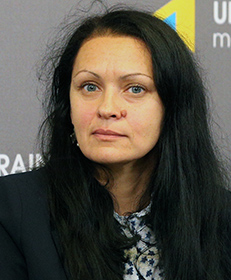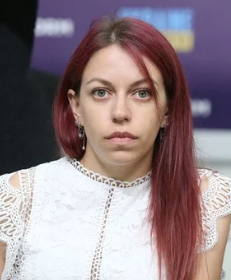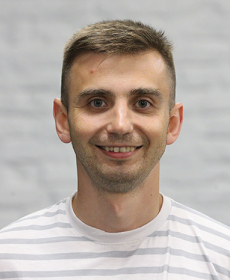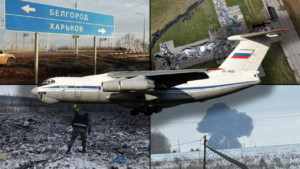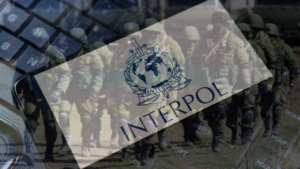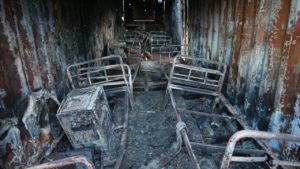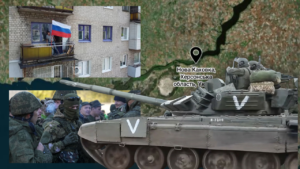Crimes in Olenivka: Chronology, Testimonies and Names of Those Involved
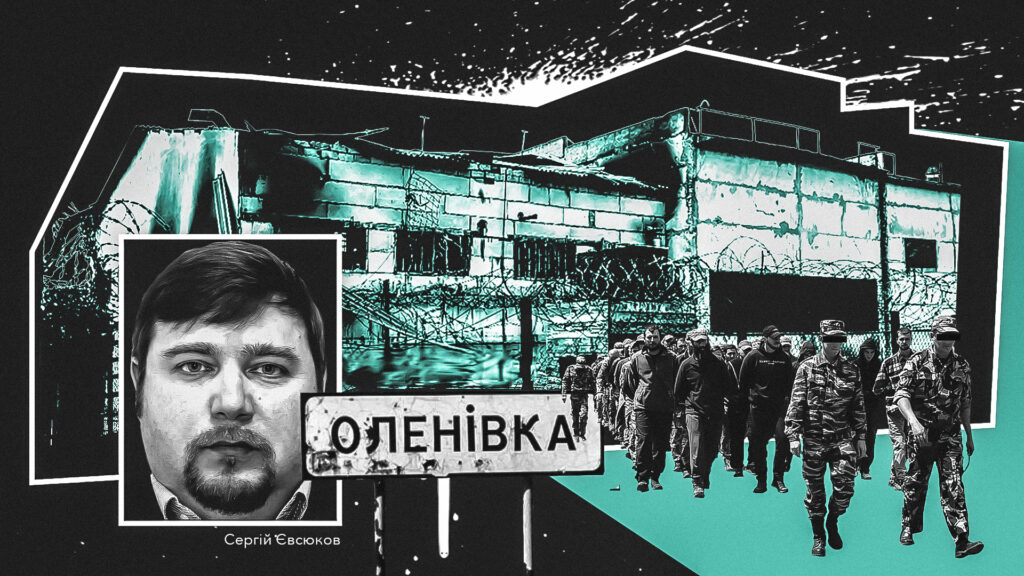
The history of creation and operation of the most notorious place used for detention of civilians and prisoners of war – Olenivka Colony – from first-hand sources.
Since the beginning of Russia’s full-scale invasion of Ukraine, the Media Initiative for Human Rights has been studying the geography of places where prisoners of war, civilians and persons detained and abducted by the Russian Federation are kept. The most notorious of them is Olenivka Penal Colony No.120 (Donetsk Oblast), where Russia detains and tortures Ukrainian citizens. At least five thousand people have been imprisoned there in the eight months since the beginning of the current phase of the war. That is where most of the defenders of Mariupol and a large number of civilians who did not pass the check for loyalty to occupation authorities (that is, the so-called filtration) ended up.
Perhaps the Olenivka colony would have remained one of dozens of prisons on the map, if not for the tragedy that occurred on July 29, when more than 50 prisoners of war died and another 70 were injured there. Olenivka became the center of attention of the entire world after that night explosion. Although almost four months have passed since that day, the circumstances of the mass killing of prisoners remain still unknown. The names of the persons responsible for this crime, creation of the prison itself and control over everything that happens there have not been revealed.
A huge number of offenses with signs of war crimes have been committed within the territory of Olenivka since February 24. Until now, it was possible to learn about them only from individual stories told by those who had been in the prison. Witnesses speak of beatings, electric shock administration, psychological torture, failure to provide medical care and inadequate nutrition. At the same time, international observers do not have access to Olenivka prisoners – Russian occupation forces isolated the prison. Even representatives of the International Committee of the Red Cross are not allowed to be there, although they have a mandate to visit prisoners.
During several months, MIHR journalists interviewed dozens of former Olenivka prisoners – those who were taken in captivity at the very beginning of the current phase of the Russian aggression, and those who stayed there until October 2022. Our team managed to reconstruct the events that took place in Olenivka, in particular on July 29, establish the names of the colony’s leadership, find a photo of its chief and hear testimonies of those who know him. In addition, MIHR investigators established that the supervisor of the colony had been representatives of the Federal Security Service of the Russian Federation.
Reactivated Torture Chamber
“They took us to the barracks. They body searched us. We were stripped naked. They took everything: food, toothpaste and brushes, medicines, cups, spoons, plates. Even socks. Someone had two pairs of underpants, they took away one of them. Sleeping bags, ground pads. Ground pads were something new for them, they didn’t know what they were and what they were for, so they threw them away,” says Yevhen, who serves in the National Guard of Ukraine.
We met with him in a hospital in the first days after the large-scale exchange of prisoners in October 2022 to talk about Olenivka. Yevhen spent four months in prison after leaving the Azovstal Iron and Steel Works on May 18, 2022, together with the entire garrison.
“I realized that the colony had not been active. It was literally reactivated just before we arrived. We were not the first: people had been kept there throughout the spring. Rules, supervisors and prisoners just changed,” he continues.
The Olenivka Penal Colony, or as it is often simply called Olenivka, is the most notorious place used for illegal detention of people since the beginning of Russia’s full-scale invasion of Ukraine.
It is located in Molodizhne, near the village of Olenivka in Kalmius Raion (formerly Volnovaskyi Raion), Donetsk Oblast, on the highway connecting Donetsk and Mariupol. It was Olenivka that gave its name to Penal Colony No. 120.

Olenivka. Screenshot from Google maps
Once this place was used as an agricultural school and then as a medical and occupational preventive medicine clinic. A penal colony of medium security level was created for men there in 1999. It could accommodate 1,100 prisoners at the same time.
It was like that until 2014. Olenivka and Molodizhne were occupied after the Russian invasion of Ukraine. In eight years, all the prisoners were taken out of the colony, and the buildings stood empty for some time.
In March 2022, captives began to be brought to Olenivka – Ukrainian servicepersons taken prisoner and civilians who had not passed the so-called filtration. They brought women and men, threw them into the barracks and cells of the punitive segregation unit (PSU).

Plan of the colony No. 120 / Collage – MIHR
On the left side of this layout, we can see a conventional residential area with barracks, PSU, dining hall, administrative building, church and garden. There is an industrial zone on the right.
“There are five barracks in the far left corner. Four are for men, and one is for women. Barracks are two-story buildings with two separate rooms on the first floor and on the second floor, with separate entrances and adjacent area. One squad lives in each of the barracks,” says volunteer Yevhen Maliarchuk, who was kept in Olenivka for almost 100 days (from March 31 to June 5).
There are a vegetable garden and an orchard next to the barracks. Captives worked there – some say that they were forced, some claim that they volunteered in order for time to go by faster.
The industrial zone, or Promka, is an area with abandoned workshops. Once, prisoners worked there – they made fence sections, paving stones and protective gloves.
“At the time the first prisoners were brought to Olenivka in 2022, the industrial zone was not operating. Therefore, there was no need to let prisoners in there,” Maliarchuk says. He assures me that if the colony was not overcrowded, captives would not have been kept in the industrial zone.
The Road to the Colony Runs through Beatings and Humiliation
Prisoners began arriving at Olenivka in the first half of March, 2022, after the full-scale invasion of the Russian Federation. These were civilians. They can be divided into several categories.
The first category includes people from the nearest settlements of Donetsk Oblast, in particular from Mariupol, who did not pass the so-called filtration – a check for loyalty to occupation authorities. Filtration took place not only when leaving the occupied territories, but also while staying there. We know about hundreds of cases when occupiers came to homes of civilians, carried out searches and conducted interrogations.
The second category comprises former participants in the Anti-Terrorist Operation (ATO)/Joint Forces Operation (JFO) or their close relatives.
The third one includes men who did their military service at the beginning of 2014 and raised suspicions because, like former ATO participants, they could help Ukrainian special services and the army.
The fourth category includes representatives of local authorities, certain medical doctors and educators. They were detained in order to examine their activities and possibility to involve in cooperation.
A separate category comprises volunteers who brought humanitarian aid to the surrounded and partially occupied Mariupol at that time and evacuated people from there. They were detained at checkpoints on the outskirts of the city.
Such detentions were usually classified by occupiers as administrative. They lasted from several days to three months. Then detainees were released or given the status of suspects, which means they were transported to the Donetsk pre-trial detention center.
Ihor Talalai, a volunteer from Dnipro, talks about possible reasons for detention. On March 19, he evacuated four people from Mariupol in the direction of Manhush (Donetsk Oblast). He was stopped at the same checkpoint that he had already passed a few hours before when entering the city – appearance of the volunteer caught attention of the people on duty there.
“I had ugg boots on my feet, they didn’t like them,” Ihor recounts the meeting with a uniformed man. Because of this, Talalai was detained and thrown into the basement. They said that he might be collaborating with the Ukrainian army.

Stanislav Hlushko was detained because he presented himself as a volunteer / Collage – MIHR
“It happened at the entrance to Mariupol. DNR officers stood there. When they asked us who we were, we answered that we were volunteers who came to take women and children. They replied: “Ah-ah-ah-ah, volunteers, then we will discourage you from coming here for a long time,” says Hlushko.
It should be noted that the vast majority of civilians did not go straight to Olenivka, before that they were sent to several other detention places.
For example, Ihor and Stanislav were first brought to a transit camps. Similar camps existed in Manhush, Volodarske, Starobesheve, Dokuchaievsk, Nikolske, Tokmak and other settlements under occupation. Detainees stayed in such camps from one day to a week before arriving in Penal Colony No. 120. It was there that they encountered violence for the first time.
“The reception was very tough there. We stood on our knees. Some people were beaten very hard. When we looked around, we realized that it was a former TDF (temporary detention facility. – MIHR). There were about 30-40 people in the cell,” says Stanislav Hlushko about conditions in Starobesheve.
The same conditions existed in Dokuchaievsk.
“They told me to put my hands in front of me. They wrapped them with tape, put a bag on my head, put me on my knees and told me to tell the whole truth. There were two of them. I replied that I had already told everything. And they insisted, “No, tell me that you are an AFU officer, where you serve, how many of you there are.” They beat me in the kidney area, used an electric shocker and threatened me. Then they calmed down. I just stood with that bag on my head for about 20 minutes,” Vitalii Borodin, another former detainee, says about his interrogation.
After these camps, many people were sent for questioning to the Donetsk Department for Combating Organized Crime (UBOZ), which, according to volunteers, is the main center for interrogation and screening. UBOZ is also a key stage before getting to Olenivka. Later, all three volunteers (Stanislav Hlushko, Ihor Talalai and Yevhen Maliarchuk) met in colony No. 120.

Yevhen Maliarchuk, volunteer / Collage – MIHR
Regime. From Reception to Liberation
Stay in the colony is divided into several stages.
At the beginning – reception. This is what happens during first hours after people are taken out of prison trucks.
“Slav squat” is a pose when you need to put your hands in a lock behind your neck and squat down without raising your heels. It was necessary to sit like this for hours. Many people could not bear it, began to move or stood up. They were beaten with clubs or kicked. At the same time, civilians and servicepersons were received simultaneously, without taking into account who is who,” says Ihor Talalai.

Ihor Talalai, volunteer / Collage – MIHR
After that, civilians were very often sent to a punitive segregation unit (PSU). Penalized prisoners (violators of the regime) are usually held there in colonies. But according to the rules established now in the colony, almost all prisoners have to go through the PSU. This is where most tortures take place. This is where a large number of people are kept in small cells.
“A cell is a room of 15 square meters. 35-55 people could be kept there at the same time. At first, both civilians and servicepersons. You could understand what time of day it was only by looking in a small window,” Stanislav Hlushko explains.
Later, prisoners began to be filtered out – civilians were kept separately from servicepersons. The number of the latter increased in Olenivka. We will talk about them later.
As for food, the PSU provided only 200 milliliters of water per person and a loaf of bread for eight persons per day. There is no centralized water supply in the PSU – water was brought in canisters. Sometimes, chow servers (prisoners who dispensed food) were allowed here.
Food is a liquid with five to six pieces of undercooked potatoes and pickled cabbage. Such “soup” was prepared in a field kitchen, there were no other facilities used for this purpose.
There was a slight improvement after stay in the PSU when detainees were transferred to barracks.
Barracks are a two-story buildings with an area where you can go freely. There were no guards there – they watched us from behind the fence. Each barrack unit had a “chief” who communicated with the colony’s leadership.
“We had about 150 people in the first barrack unit. We were given wooden pallets to sleep on, but there were still not enough of them,” Ihor Talalai recalls.
Waking up is at six o’clock every morning. Everyone lines up, and guards make a roll call by names. This lasts for half an hour in each barrack unit.
Meal is about 11 o’clock. Ihor Talalai describes it briefly, “You stand there, hungry, waiting for your turn to eat and be hungry again.”
The situation changed over time. In particular, in April 2022, when a thousand captured marines were brought to the colony, as well as in May, when defenders from Azovstal were brought here. For example, Yevhen from the National Guard of Ukraine recalls, “They came and told to line up for breakfast. It was about at 12:00, but in fact at 1:00 p.m. Lunch was at 8:00 – 9:00 p.m. Dinner was already at 4:00 – 5:00 o’clock in the morning. They took everyone to a dining room.”
People who were kept in barracks, especially civilians, were involved in works. Volunteers say that one could avoid works only at the cost of punishment (beatings) and transfer to the PSU.
“Absolutely all works in the prison were carried out exclusively by prisoners, captives. There were no full-time employees except guards. Prisoners dispensed food, prisoners cooked food, they worked on the land (took care of the prison vegetable garden and orchard) – all these works were carried out by prisoners. The head of the colony was particularly interested in agriculture. After some time a stationary canteen was opened – prisoners also worked there,” recalls Stanislav Hlushko.
Renovation works in Olenivka were also carried out by prisoners. Moreover, families of prisoners had to buy building materials.
Some people were also involved in registration of prisoners of war. “They started bringing servicepersons from Azovstal. Our job was to meet servicepersons, make a description, take pictures – in other words, compile a database of prisoners of war. They collected all personal data as much as possible, like a bank,” says a man released from captivity, who asks MIHR not to reveal his name.
After the period of the so-called administrative arrest ended, some of the imprisoned civilians were released. Usually, on the day of release, guards came and called names, saying “Bag and baggage!” Most of the prisoners were convinced that they would either be transferred to another barrack or PSU, or taken to Russia to another detention facility. However, according to testimonies given by civilians, some prisoners were simply taken outside the gates of the colony. No money, documents or phones.
In order to receive documents and a filtration certificate, it was necessary to apply to UBOZ and wait for the decision of the investigator, who sent them to Olenivka.
Being a Prisoner of War
Ukrainian servicepersons began to be brought to Olenivka in March as well. At first, one at a time or in small groups.
Civilians tell MIHR that tortures, including beatings, were used more often against servicepersons in Olenivka. This happened mostly in the PSU. They remember the room on the first floor, where captured servicepersons were brought in the evening or at night. Then they turned on loud music in the room, and there were the screams of people who were tortured. After beatings, people were forced to climb to the second floor squatting. According to former prisoners, some people were not able to do this because of tortures, so they barely managed to crawl up the stairs.
On April 12-14, about a thousand marines were brought to the colony – mainly fighters of the 36th Separate Marine Brigade Named after Rear Admiral Mykhailo Bilynskyi. Some of them surrendered, some decided to break out of the Ilyich Iron and Steel Works and were also captured. Members of the 56th brigade, territorial defense forces, National Guard, and medical staff of military hospital No. 555 were brought to the colony together with them.
“Girls were taken out. They were told to lower their heads and not to look around. And boys who got off buses were beaten with batons,” recalls Olena Turas, who serves in the 36th brigade. “You go out and say your last name, first name, patronymic, position and rank. And they beat depending on your position – the higher the position, the more hits you get. As they explained to us later, that was a kind of a ritual.”
Anastasia Rustamova, also a member of the 36th brigade, adds, “A truck stopped near the barracks, and two or three people at a time were let out from there. There were about ten soldiers in balaclavas standing there with dogs and batons, and they started beating the boys. We watched this from windows of buses. Then they were ordered to run. When they ran, dogs were set upon them, and they bit their legs. The boys fell again, and they were beaten with batons. And so it was with everyone. One guy was forced to take up a stretching posture (legs and arms at shoulder width. – MIHR) near the barracks. They approached him and beat him. He fell. They picked him up again and baited the dogs.”

Prisoners of war are escorted by guards / Screenshot from the video
There was a shift of particularly brutal guards in the colony. MIHR journalists heard about them from several released prisoners. “As soon as this shift goes on duty, they immediately call Azov Regiment soldiers, after which screams are heard from the room,” they say.
There was a man named Kyrylo (some called him Kiryusha) among these guards. He looks to be 30 to 35 years old. He has blond hair and a scorpion tattoo on his forearm. The other one is Yurii, aged 45 to 50 years. Both limped and boasted that they had been in combat.
“When new people were received, it often happened that this shift was on duty,” says Dmytro Bodrov, another volunteer who was freed. “Our cell, just a cage, did not have an iron door, so we could see the first floor. When soldiers were received, they were forced to assume a “Slav squat” position, stripped naked and beaten with rubber batons all over their bodies. Then those places where skin cracked from blows were watered with brilliant green and they were ordered to go to their cells while squatted.”
In addition, MIHR found out about the murder of a prisoner of war, a soldier of the 36th brigade, in Olenivka. A army medic, who was in the colony at the time, told us about it.
“His codename was Casper. He was a quiet and calm guy. He was wounded in action, survived two airstrikes in Mariupol and got burns on his face. He was beaten to death during the “reception”… He stood in front of me. If it were not for his death, we, those who stood behind him, would have been beaten just as hard. And the wildest thing is that everyone knew that a whole bus of the injured had arrived. All soldiers were on crutches, all of them were bandaged, strapped up, and we, medics, were nearby. It would be possible to let this bus in without this “ritual”. Nothing stopped them. There was a guy with a crutch. They took the crutch from him and beat him with it. I saw him lying, and they (guards, – editor) stood over him and watched what would happen next. The head of the colony came up to them and said that they shouldn’t have been beaten so hard.”
On May 16-20, Azovstal defenders were brought to Olenivka – they included soldiers of the Azov Regiment of the Ministry of Internal Affairs, other National Guard members and servicepersons, in particular, conscripts, police officers, border guards and marines.
Not long before that, the situation in Olenivka changed dramatically. “For example, Russian tricolors began to appear instead of DPR flags. New guards, probably Russians, arrived to replace usual guards from Donetsk,” says one of the released prisoners.
Women. A Different Treatment
Women have also been kept in Olenivka from the very beginning. At first only in the PSU, then also in one of the barrack units.
“They took us to the colony and immediately sent us to the PSU. That was a building with cells, corridors and a little courtyard arranged as a cage. There were half-broken window frames, rusty gates, stench and cold in our cell. Everything was miserable and abandoned there. It measured 7 square meters and had two beds (plank beds) and a window (80 by 30) with little holes made in an iron sheet welded to the window frame. There was no sunlight. The door was wide open. Guards tried to insulate all this themselves, hung blankets. There was no water. It was impossible to go to the toilet – the sewer was clogged,” says Anna Vorosheva, a volunteer from Mariupol.

Anna Vorosheva Photo from Twitter
On April 12, in addition to hundreds of men, two buses of women, approximately 80 servicewomen in total, including medics and marines, were brought to the Olenivka colony. Women were taken to the PSU.
“All laces were removed from women’s clothes, and even metal parts were cut from bras,” says Anastasia Rustamova. She recalls that 40 women were put in a cell designed for six persons.
“There were six beds, one of them was broken, so it couldn’t be used. There was enough space just to sit down. We spread out jackets, ground pads and sleeping bags, we had, on the floor. We slept in turn. There was not enough water. 40 women were given a five-liter bottle of water per day. Hygiene products were not available, so women who had periods had to use their own clothes. We lived like these six days. Then some women were transported to Taganrog, the Russian Federation,” adds a servicewoman, a former prisoner of war.
At the same time, Vorosheva, a volonteer, was in the PSU, but in a different cell. She and six other female prisoners lived in a cell with two beds: “We asked for a permission to peel potatoes in order to drive away bad thoughts and not to die of boredom.”
On April 18, all the women who were kept on the first floor in the PSU were moved to the second floor in order to making room for prisoners of war. Anna Vorosheva stayed there until she was released on July 4. Rustamova was exchanged at the end of April.
Waiting for Azov Regiment Soldiers
Ukrainian defenders began to leave the Azovstal Iron and Steel Works on the evening of May 16, 2022, after a three-month defense of Mariupol. Most of them were soldiers of the Azov Regiment of the Ministry of Internal Affairs. On May 20, the Ministry of Defense of the Russian Federation announced that over 2,000 Ukrainian soldiers who were on the premises of Azovstal were captured.
The Russians sent some of the wounded to hospitals within the occupied territory, in particular to Novoazovsk, and all others were transported to the Olenivka colony. The first night, they were kept in buses near the colony, and reception began in the morning.

Prisoners in Olenivka. Screenshot is made from a video from Russian Telegram channels
“We were received by prison guards, who came from Kuban (probably, he is talking about representatives of the Federal Penitentiary Service of the Russian Federation, because, according to testimonies given by detainees, they were the ones who supervised the colony. – MIHR),” says one of the formerly imprisoned Azov Regiment soldiers, who, despite a serious injury, ended up in the colony. “They were dressed in the uniform that sailors wear, the blue one. Others had camouflage, as if they were members of special forces. We saw them wearing our army boots.”
A separate barrack unit was allocated to Azov Regiment soldiers. As they say, it had the best conditions, because “DPR guards” lived there before them.
“Our barracks had a large corridor with small rooms on the sides and a large one at the end. We lodged the wounded in smaller cells, all the others were in the big one. There were iron bunk beds. There were not enough of them for everyone. There was no extra space to put additional beds. For that reason, we moved them so that two beds could accommodated three people. They became insufficient over time. We slept on the floor,” adds an Azov Regiment soldier.
They were forbidden to communicate with other captives, only with each other.
Azov Regiment soldiers, freed from captivity in October, say that there was not enough food. When they were just brought, they were given a quarter of bread and water. They were fed once a day the first week. They could wake you up at three o’clock in the morning, give you something to eat – only those who was fast enough could expect to take some food. Some boys simply fell down during line-ups. They lost consciousness due to malnutrition. Then Russians decided to feed prisoners three times a day.
“It was possible to communicate to a certain extent with Kuban guards,” the soldier continues. “But they were replaced in two weeks. At the end of May (beginning of June), other guards arrived from Voronezh. They were aggressive. They constantly conducted line-ups. The Russian national anthem was played already at 6 o’clock in the morning. Those who did not sing were taken out. They constantly repeated that no one needed us, that they had occupied Kharkiv, that they were already near Kyiv. It was all very disrespectful. If someone smiled, they were immediately thrown into the pit. It was somewhere in a separate place near the PSU. Azov Regiment soldiers were also taken there. Boys stayed there for five days. And they laughed because they were dressed very funny: wedding shoes, white socks, strong perfume.”
Prisoners were interrogated all the time. Some captives were questioned longer and more often, some of them were questioned rarely and quickly. Interrogations were conducted by representatives of the DPR and Russian Main Intelligence Directorate (GRU).
“During first hours in Olenivka, they asked who you are, where you come from, who your parents are. Russians came, took fingerprints, examined all tattoos and took pictures. Then Federal Security Service officers conducted interrogations. They said, “Tell me why you bombed Donbas?” Later, GRU officers came with the same equipment. They took fingerprints and checked tattoos. It was obvious that they came from Moscow. I understood that a professional was working with me: he studied my facial expressions and reactions. He already knew where I had served before. He asked about the boys, who mined what, who did what,” recalls the former prisoner of war. “They said that someone had been killed there. As far as I know he was from the 36th brigade. They were drunk, and he started talking back and was simply beaten to death. Someone was taken to dig a grave, someone was taken to Voronezh and then returned.”
According to an Azov Regiment soldier, the situation was tense in the colony: “Russians seemed to have planned a provocation. And why would they bring Grads so close that we could see them though our windows? Then new guards said that if we did not cooperate, Ukrainian army would shell us or they would help us die.”
Olenivka Massacre
On the night of July 29, an explosion sounded within the territory of the Olenivka colony. In the morning of July 29, the Russian Federation announced that the Armed Forces of Ukraine launched a precision strike from HIMARS on one of the barrack units where Azov Regiment soldiers were kept: over 50 people died, about 70 were injured. The injured were taken to several hospitals in Donetsk, but nothing is known about their condition. No international organizations were allowed to visit them.
On the same day, MIHR sources reported that the tragedy had occurred not in the barracks where the prisoners of war were kept, but in the industrial zone, approximately 300 meters away from the main group of residential buildings. About 200 Azov Regiment soldiers were transferred there the day before.

Place of the explosion / Screenshot from Google maps
“I looked at those lists. There were one officer and one master sergeant from sappers. Russians understood that there was no point for soldiers to be there. If they take officers, then there will be a big scandal. So they chose those having middle ranks. They destroyed the backbone,” says the Azov Regiment soldier.
Yevhen from the National Guard of Ukraine became a witness to the events in Olenivka on the eve of and after the explosion. He says,
“Our barrack unit was in close proximity to the industrial zone – we could see it from the second floor. No one was kept there before. Two barracks began to be built there two weeks before the explosion. One was designed for 200 people, the other one was for 50 – 60. Our boys were involved in the works. They did everything in a hurry. They said that all works should be done in seven days, but they managed to complete them in five days. We thought that Russian prisoners of war, transferred here as a result of exchanges, would be brought there. In my experience, they did not want to do anything for our soldiers – we had asked to screw in a light bulb in the barracks for two months, but I think it is still not in place. And suddenly, electric cables were laid and beds were placed in the new barracks – some normal living conditions were created.”
They waited for something two days. Some began to say that women were expected to be transferred to those barracks.
And then they suddenly began to move Azov Regiment soldiers there.
“They went by us. We did not understand why them: their barracks were least overcrowded. Moreover, completely different people were transferred: from support and intelligence units. There were officers and soldiers,” Yevhen continues. “Grads worked the day before – the imitated shelling. They generally worked constantly. Tanks, Grads, Uragans – these fired from all sides, we got used to that. And then we clearly heard two Grad blasts and two explosions – one was louder, the other one was quieter. This sound was familiar for many of us. It was similar to the explosion of a thermobaric weapon. Later we saw the roof of that building – iron sheets were turned outwards.”
A soldier freed from captivity says that he went up to the second floor to see what was happening. He saw guards running around. Most of them arrived in Olenivka the day before and did not have enough time to familiarize themselves with the colony.
“An important point: guards were given weapons shortly before the explosion. Before that, only the perimeter of the colony was guarded by armed men who had only batons and pepper spray,” Yevhen adds.
He is sure that after repair works were completed, no one was there for two days – during this period of time, explosive materials were brought there.
“Then I watched the video, and those who worked in that barrack unit said that there were stairs to the second floor – it was used as an observation deck, so they could have planted it there. Because the boys would have seen what was there if it had been placed in other places. We did not know what had happened until morning. Our guys also collected corpses, they said that there were about 50 dead bodies. Around 10:00 a.m., they heard on the local radio that Olenivka had been fired upon. The injured were taken to the punitive segregation unit. Some of them were transported to hospitals, some were given aid in the PSU, they were not taken out of Olenivka – they were returned to the barracks, but they were kept separately from everyone else, together with Azov Regiment soldiers,” the witness says.

Barrack to which the prisoners of war were moved after the explosion / Screenshot from the video
The army medic interviewed by MIHR is another witness to what happened that night.
“Cries could be heard in the colony for about an hour… Cries of people asking for help,” he recalls. “Then a representative of the administration came and said, “Guys, it’s a f*cking disaster. Take everything you have and let’s go.”
The place of the explosion was surrounded by colony guards. The medic heard automatic gunfire.
“There were a gate and a net. The guys who were there broke through this net. The guards started shooting. Most likely they were shooting in the air, and I heard the orders “don’t walk on the lawn”. They were afraid that someone would try to escape,” the witness says.
All those who survived the explosion ran out onto the road behind the buildings. The entire road, according to the medic, was covered with bodies. The injured told him that there had been about two hundred of them. It was later found out that 47 of them died on the spot. Others were bleeding.

Blood-covered stretchers on the colony territory after the explosion / Screenshot from the video
“Representatives of the administration calmly watched people die all night long. They only lacked popcorn. They watched through the fence as I performed cardiopulmonary resuscitation. No evacuation was organized. During this period of time, five more people died whom we could not help. Later, their bodies were shown under the fence. Most of the wounded received head injuries,” says the medic. “Everyone was taken away using ordinary freight transport. We provided medical aid as best we could. We pushed as many of the wounded as possible into the vehicle. When we informed the administration of the number, they told us, “Are you totally crazy? Sort the wounded. You will take care of those with minor injuries here, only those with severe and moderate injuries will be sent to the hospital.” We sorted them and sent severely and moderately injured prisoners to the hospital, and those having minor injuries were left in the colony. They were sent to the PSU. In addition to being injured, they were pushed into this “Mordor”. 20 people with various injuries were stuffed into 4-bed wards.”

Dead prisoners of war / Screenshot from the video
What exactly was used during the terrorist attack in Olenivka and what happened that night should be established by investigators. Russians returned dead bodies of Azov Regiment soldiers to Ukrainian authorities, so experts should identify traces of the substances that remained on these bodies. However, MIHR found out that the work of specialists is complicated, because some of the fragments were removed from the bodies in the occupied territory, and corpses were kept in a damp basement.
Probable Responsible Persons
After the full-scale Russian invasion of Ukraine, the head of Olenivka was officially appointed, and staff was hired in occupied Donetsk. At the same time, it can be assumed that these appointments were made earlier, since Russia carefully prepared for the war.
Despite the fact that the prison was actually created from scratch, the old rules remained in it. Human rights defender Oleh Tsvilyi points out at this. He knows well the inner workings of penal colonies and claims that the approach to management of such institutions has not changed in the so-called LDPR since Soviet times. Leadership of colonies is mostly represented by the head, his first and several other deputies.
“One is responsible for public relations, the other one – for security issues. There is also a chief of the operations unit who can be considered a deputy. In addition, they have a chief of the industrial zone, head of the security department, head of the economic department and head of the judicial affairs department. There is also a number of all kinds of inspectors,” Tsvilyi says.
The operations unit personnel is a privileged group of employees. Ukrainian human rights defenders have been fighting to remove this structure from colonies for more than 5 years. However they operate successfully in Russia and within the occupied territory of Ukraine. In Olenivka, it was operations unit employees who did the dirty job – they tortured and beat people. This is confirmed by several former civilian prisoners of Olenivka.
Moreover, according to Oleh Tsvilyi, there was a unit of the so-called “activists” in Olenivka – prisoners who were transferred from other colonies in order to control and exert pressure on captives. Usually these are the prisoners who are not respected by prison inmates. The presence of such characters in Olenivka was noted by at least three civilian hostages interviewed by MIHR, who were held there in March-May, 2022.
Most of the surnames of these people are not yet known.
“There were guards who moved around without a mask, but most had balaclavas. It is interesting that lieutenant colonels and the colonel walked without masks, and their subordinates wore masks,” says the Azov Regiment soldier.
MIHR managed to establish family names of key persons – those who were put in charge of the colony by the occupiers. Almost no information can be found about them in open sources, although the persons we identified worked in law enforcement agencies and held managerial positions until 2014.
Serhii Yevsiukov acted as the head of penal colony No. 120. Several former prisoners mentioned this last name, and later they recognized him in the photo.

Serhii Yevsiukov, head of penal colony No. 120 / Collage – MIHR
Olenivka prisoners describe Yevsiukov as a person of mood.
“I think he suffers from some kind of bipolar disorder. One time, he can go by and ask: “How are you doing?” And next time he can start screaming for no reason. In order for you to have better understanding, this is the person who sent people to the PSU only because someone, leaving the dining room, could pluck a cherry off a tree,” says Yevhen Maliarchuk.
There is little information about Yevsiukov available in open sources. We know that, until 2014, he worked in the Horlivka Police Department, held the rank of a major and headed the sector for combating human trafficking and crimes against morality. He was responsible for fighting the porn industry.
MIHR journalists talked to Yevsiukov’s former supervisor Herman Prystupa. From 1991 to 2014, he worked in the Horlivka City Department of the Main Department of the Ministry of Internal Affairs. In 2009, police lieutenant colonel Serhii Yevsiukov joined employees of this station.
According to Prystupa, Yevsiukov graduated from the Donetsk Institute of Internal Affairs and lived in Svitlodarsk, Donetsk Oblast. He moved to Horlivka from Yenakiieve, where he had served in the Department for Combating Organized Crime.
In November 2010, Herman Prystupa was appointed Deputy Chief/Chief of the Criminal Police of the Horlivka City Department of the Main Department of the Ministry of Internal Affairs. Yevsiukov became his subordinate.
“There were no doubts about his professional competence. The sector, headed by Yevsiukov, demonstrated high efficiency in fighting crime in his area of responsibility,” says Prystupa.
At the same time, he adds that Yevsiukov was a very ambitious person and believed that he should occupy a higher position in the police. “In my opinion, his ambitions resulted in his joining the DPR militia after the capture of the Horlivka Police Department in 2014,” says Prystupa.
For some time after Horlivka, Yevsiukov worked in the militia in occupied Donetsk. And then, according to unverified information, he served in the so-called DPR Arbitration Court that he probably left to become the head of the Olenivka colony.
Viacheslav Yakurnov was in charge of the operations unit in Olenivka. Some of the released prisoners call him Yevsiukov’s deputy.
In 2013, Yakurnov worked as a criminal intelligence detective of the Operational and Investigative Sector of the Donetsk Main Department. After occupation of Donetsk Region, he broke his oath and was included in the list of traitors who switched to the side of the DPR.
“The one who was in charge of the operations unit is the sickest person in the entire colony. He was responsible for all beatings. He pointed out at the person who would be interrogated and tortured. When we did repair works, he went back and forth and supervised. He frightened us, “If you do not do well, you will be transferred to the PSU.” When we finished repair woks and we were still transferred to the PSU, we asked him why. He says, “I don’t give a f*ck. And in any case, we will imprison you for 15 years if you ask stupid questions.” This is how one of the released hostages characterizes Yakurnov.
Despite the fact that Yevsiukov and Yakurnov are former employees of Ukrainian law enforcement agencies who broke their oath, criminal proceedings were not initiated against them, for example, under Article 111 (high treason). The SSU informed MIHR about this in response to an information request.
After the terrorist attack in Olenivka, Yevsiukov was removed from leadership of the colony and demoted to the deputy head, and another person was appointed the head.
It should be noted that servicepersons were taken to Olenivka directly – they were brought here immediately after being captured, while civilians ended up in the colony according to decisions made by local occupation authorities, primarily the UBOZ. After February 24, it assumed the leading role of a punitive agency (before that, the “Ministry of State Security” was considered more important). So the UBOZ leadership has a direct relation to Olenivka.
UBOZ is headed by Oleksandr Sheptura. He is also the Deputy Minister of Internal Affairs of the DPR. It is known that in October 2013, during staff rotations, Oleksandr Sheptura, who held the rank of the lieutenant colonel of the police at that time, was appointed Acting Head of the Criminal Investigation Department in Donetsk Oblast.

Oleksandr Sheptura, head of UBOZ
But in less than half a year, after occupation of Donetsk, Sheptura switched to the side of the so-called “DPR”, and, in 2015, he headed the local UBOZ. Over seven years, Sheptura achieved the rank of major general, and, in the spring of last year, he received an award from Denys Pushylin, the head of the pseudo-republic. It is interesting that, despite such publicity, Sheptura managed to remain unnoticed by Ukrainian law enforcement agencies. He fell under suspicion of high treason only on August 5 of this year, when a huge number of people went through the horrors of the Donetsk UBOZ.

Oleksii Dykyi, the so-called “Minister of Internal Affairs of the DPR”
Oleksandr Sheptura is considered to be the “right-hand man” of Oleksii Dykyi, the so-called “Minister of Internal Affairs of the DPR”. And since UBOZ is a part of the so-called “Ministry of Internal Affairs”, Dykyi is also responsible for crimes against detained Ukrainians. By the way, before the start of Russia’s armed aggression in 2014, he headed the Donetsk UBOZ, and then he broke his oath to become a “minister”. He personally gave comments to Russian propagandists about the capture of Azov Regiment soldiers. He described the hell existing in Olenivka as the conditions that meet Geneva Convention requirements, and promised to initiate a “thorough investigation and court proceedings against Azov Regiment soldiers.”
Oleksii Dykyi is the only person of all those responsible for Olenivka incident who has a verdict delivered by a Ukrainian court. In 2017, he was sentenced to 12 years in prison for “participation in a terrorist organization.”
But representatives of the “DPR” are just pawns on a large chessboard, where Yevsiukov and Yakurnov are instruments. Russians established control over the prison in May, 2022. This is emphasized by almost all Olenivka prisoners interviewed by MIHR. The vast majority of them note that representatives of the Main Intelligence Directorate and the Federal Penitentiary Service of the Russian Federation were present in Olenivka, for example, if a decision was made to transfer a person from Olenivka to Russia. “Before putting us on a bus, we underwent a mini-interrogation – talked to people who came to Olenivka specifically. They did not introduce themselves, hid their faces, spoke exclusively in Russian and did not understand the Ukrainian language,” recalls Anastasia Rustamova, a former prisoner of war. She was transported from Olenivka to Taganrog in Russia.
“The supervisor used to come to us. We had to line up near the barracks. He did not reveal his last name. And then some general came together with Kuban people. We saw that there were a lot of security officers around, but I don’t know his name,” says another prisoner.
The events that occurred in Olenivka are the subject of the investigation conducted at the international and national levels. Ukrainian law enforcement officers and prosecutors examine the materials collected during several months of investigation. MIHR is ready to provide the testimonies obtained in the course of this investigation, because it is very important that the suspects are charged not under general criminal articles, but under Article 438 of the Criminal Code of Ukraine “Violation of the Laws and Customs of War”. This will allow us to talk specifically about war crimes committed against Ukrainians by representatives of the occupying forces. In particular, attempts to deprive prisoners of war of their rights protected by the Geneva Convention on Prisoners of War.
According to MIHR’s own sources, Russians brought all servicepersons from penal colony No. 120 during September-October 2022. Moreover, they mixed up prisoners according to alphabetical lists on a daily basis. The vast majority of marines, National Guard members and border guards probably ended up in prisons located on the territory of the Russian Federation, particularly in Rostov and Volgograd Oblasts. Their relatives lost contact with prisoners of war. As for civilians, they are still kept in Olenivka.
—————
The material was prepared by the Media Initiative for Human Rights with support from the Hela Sverige Skramlar for Ukraina project.


